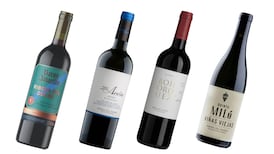We should be thankful modern technology means we no longer have to put up with the acidic whites and raw tannic reds that were commonplace not too long ago, writes JOHN WILSON
I went to a tasting of some of the cheapest wines available on the Irish market today. Not as cheap as Lidl or Aldi, but not far off. There were some 120 wines opened (I didn’t taste them all) and barring about half-a-dozen, all are for sale at under €10, some as low as €6, a bottle.
The company concerned supplies wines to most of the major supermarkets in this country, often very similar wines presented under a different label. The importer told me that after the last budget, many of his wines cost less than one-third of the duty currently levied by the Government. Excise duty on wine being €2.78 a bottle (excluding Vat) that means he is paying less than €1 for a bottle of wine.
So, leaving any prejudice aside, how were the wines? Generally, the white wines were light, with just enough soft fruit and a little residual sugar. The reds were light too, with rounded ripe fruits and no rough edges. They came from half-a-dozen countries around the globe, yet tasted very similar. The Portuguese wines stood out as different, possibly because Portugal has its own unique grape varieties.
At wine tastings, I have a frequently used shorthand of SDW – for sound drinkable wine; just above this is the WMSW category covering well-made simple wine.
The two together probably make up 70 per cent of wines that I taste, covering the mass of well-made but unexceptional wines on offer. On this occasion, it was more like 90 per cent. There were very few if any undrinkable wines. This is modern winemaking, and the kind of wines that make it on to the shelves of our supermarkets, as well as many off-licences.
I try to avoid being a wine snob. Many consumers buy wine simply as a pleasant alcoholic drink, and have no interest in where it comes from or what it tastes like, so long as it is not awful. I don’t have a problem with this, although I do think they are missing out on a world of pleasure. It is the difference between eating a Big Mac and a shoulder of lamb prepared by a skilled chef. Both are made from inexpensive ingredients; one offers consistency, the other a lot more interest.
The most expensive “Michelin-starred” wines are generally very lucrative for the producer but produced in small quantities. The cheapest are profitable only if made in large efficient industrial plants. Between the two extremes lies the vast majority of producers. It is this middle-ground that can offer the best value and the greatest excitement.
The phrase hand-crafted is frequently abused in marketing, but every wine-producing country, and Europe in particular, has a host of small- to medium-sized producers each trying to produce something unique and different in every vintage.
Not all succeed and some are certainly more talented than others. For every really good wine you come across, there are probably a dozen or more that are little better than the “industrial” wines described above, and some are a lot worse.
To return to my food analogy, a good chef will source the finest humble ingredients and work wonders with them. A bad chef won’t do either. A small or medium-sized producer will pay more for his labels, bottles and closures; he or she will often deliberately keep yields low to increase the intensity of flavour in the finished wine. A good producer will discard any inferior grapes. But most importantly they will give their wine an individual stamp that marks it out as something more interesting than its less expensive rivals.
Inexpensive wines will always have an important place in our wine-drinking. We should be thankful that modern technology means we no longer have to put up with the acidic whites and raw tannic reds that were commonplace not too long ago.
Following the recent increases in duty, the pressure on small producers, importers and independent retailers who work with these wines is greater than ever. However, we should never forget that for a few euros more, we can enjoy one of life’s great pleasures.
This week, two budget wines and two more expensive wines from family-owned estates.
Bottles of the week
Viña Montecruz Tempranillo, Valdepeñas, Spain 2011 13% €6.99Soft , light, strawberry fruits with an easy finish. It won't set the world alight, but a decent gluggable wine. Stockists: Mace, Spar
Allegrini Valpolicella 2011 13% €14.99From one of the best producers in the region, a delicious, smooth, elegant wine with succulent black cherry fruits. Stockists: Donnybrook Fair
Château la Grave Expression 2010, Minervois 13% €13Medium-bodied plump rounded dark fruits with a nice spicy edge. Perfect with lamb or pork dishes. Stockists: 21 Pery Square, Limerick; Next Door outlets
Grand Arte Touriga Nacional 2008, V.R. Lisboa 13.5% €12 down to €9 on promotionA very drinkable example of Portugal's finest grape. Smooth, meaty, dark savoury fruits. Stockist: Superquinn











